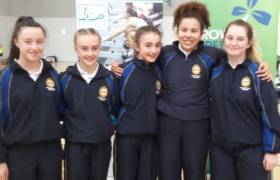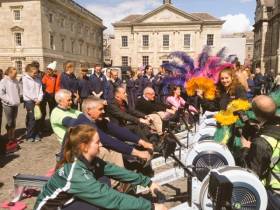Displaying items by tag: Get Going Get Rowing
Indoor Rowing Blitz A Big Success
#Rowing: The All-Ireland Schools rowing Blitz in Trinity College, Dublin today was the culmination of weeks or hard work in the Get Going...Get Rowing schools programme. Trinity College saw hordes of bus loads coming from Limerick, Cork, Galway, Carlow and Dublin, where the programme started just over two and a half years ago. The initiative, which was run with a number of sporting partners, brings rowing machines into schools and gives students the opportunity to row on a four-to-six-week programme. The ethos of Get Going...Get Rowing is to "commit to giving students a sport and a pathway for life". Each student gets an on-the-water experience as well as ergometer (rowing machine) training and technique together with a fun active environment in schools.
Over 600 students from well over 30 schools came to Trinity Sports Hall. The ages ranged from 13-year-old first years to transition year students, who had completed the TrY Rowing leadership course. In a busy and exciting day medals went to schools in Carlow, Galway and Dublin. Killarney, the only team from Kerry which travelled, also took home medals.
There will be more events throughout this year, with Carlow hosting one on December 9th. Indoor rowers are moving to the water - 100 students in Leinster alone have joined clubs.
RESULTS
Girls U/14
Dominican College Galway
Presentation, Terenure
Sutton Park, Dublin
Girls u/16
Dominican College, Galway
Kings Hospital, Dublin
Salerno, Galway
Club/open girls
Laurel Hill, Limerick
Carlow Schools
Salerno, Galway
Club/open boys
Kings Hospital, Dublin
Presentation, Killarney
Carlow Schools
U/16 boys
CBC Monkstown
Borris Vocational School
CBC Monkstown
Drea Helps Young People Complete Road to Rio
#Rowing: The Road to Rio row came to a spirited conclusion in Parliament Square at Trinity College today. Ireland Olympians Sean Drea and Brendan Dolan and Eimear Lambe, younger sister of soon-to-be Olympian Claire, were among those taking part in the final push. Ministers Michael Noonan and Frances Fitzgerald visited the stand. Thousands of young people had done stints on ergometers, with the distances they covered counted off the 9195.97 kilometres from Ireland to Rio de Janeiro.
Trinity College Prepares for Rowing Blitz
#Rowing: The inaugural rowing blitz for those who are new to the sport of rowing will take place this Friday, November 13th at Trinity College, Dublin. More than 400 competitors from around Ireland are set to take part. The event will not only give students the opportunity to test themselves as indoor rowers in a competitive environment for the first time, it will also give these youngsters a feel for what university life has to offer.
RTÉ news2day will attend the event.
The day will feature talks from former Olympian and World Championship medalist Neville Maxwell, physiotherapist and Trinity lecturer Dr Fiona Wilson – who will deal with rowing posture – and Sally O'Brien, won the women's senior eights championships in with Trinity (Dublin University Ladies' Boat Club) in 2015.
The winner of each category will receive a trophy and medals sponsored by Leinster branch of Rowing Ireland. Each category of winners will also receive free entry into the Irish Indoor Rowing Championships, which will be held at the University of Limerick sports arena in January.
The event will be facilitated by students rowing at Trinity college, together with over 70 students who have trained up over the last months to be Rowing Ireland transition year coaches.
Racing will start at 10am and the programme will finish at 2pm.

























































